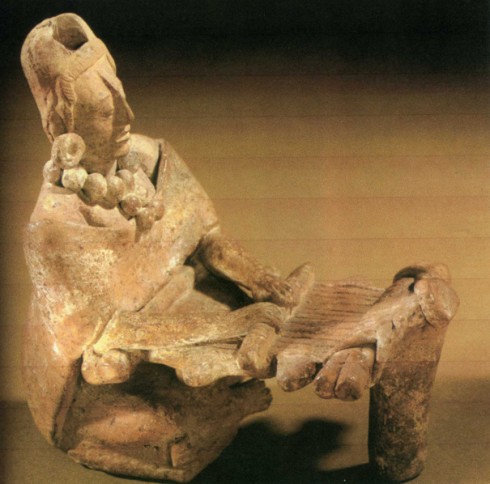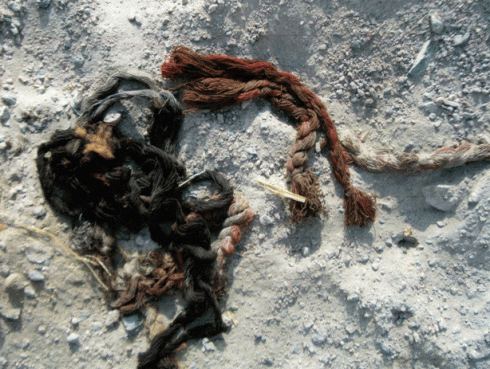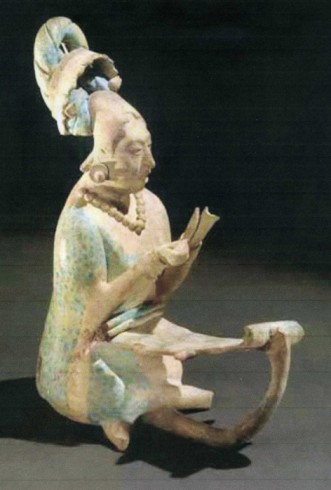Recently I was reminded that our knowledge of the weavers who preceded us is sometimes fairly spotty. Many of us are prone to believe that history and technology progress in a straight line from primitive beginnings to our modern, sophisticated world. In reality, a straight line does not define the history of weaving.
While hand weaving may have begun with twining, progressed through the belt and backstrap looms and culminated in our era in the jack loom and even the computer-assisted marvels, it probably wasn’t all that easy. We’ll never know for sure.
One of our biggest problems is that most of the climates of the world destroy textiles before they can enter the historical record. Only in rare environments, specifically bogs and deserts, do the elements combine to preserve, rather than to obliterate, the evidence of past textiles. On top of that, most evidence of the past was written about the lives of important people, and textile workers, along with all the other unimportant working people, seldom got much attention. Therefore, the archaeological record has to be read indirectly, which requires that those interpreting the evidence need to have specialized knowledge.
Some of you know that I am a bit of a nut about ancient textiles. Part of that comes from my own fiber experience, but being married to an archaeologist has exacerbated my tendencies. For many years we worked in Mesoamerica, particularly the tropics. The joke among my archaeologist friends is that I am an expert in Lowland Maya textiles. This is like a Tahitian being an authority on building snowmen, because, just as it doesn’t snow in Tahiti, the tropical soil and moisture conditions mean that there are no textiles for me to study. The sum of textiles excavated in tropical Belize, Guatemala and Mexico is exactly zero. A couple of mat imprints on the bottom of a pot-in-the-making and some transfers of paint or dye to stone artifacts wrapped in a now-decayed cloth and that’s it. Fortunately, some extremely detailed and elegant wall and ceramic paintings and carved stelae inform (or taunt) us with images of what might have been. You can see why my Society for American Archaeology buddies call us the Fiber Perishables Interest group. Nevertheless, it’s easy to envy Martha Stanley, because the Great Basin and Anasazi area of the American Southwest are a lot kinder to fibers.
 Both of these ceramic figurines are from the Maya burial island of Jaina in the Gulf of Campeche. They are probably 1500 to 2000 years old and are thought to be images of the goddess Ix Chel, the patroness of weavers. From the Justin Kerr photo collection
Both of these ceramic figurines are from the Maya burial island of Jaina in the Gulf of Campeche. They are probably 1500 to 2000 years old and are thought to be images of the goddess Ix Chel, the patroness of weavers. From the Justin Kerr photo collection
When we worked in South America, in coastal Peru, the situation was reversed. Food and Agriculture Organization of the U.N. climate records report average annual precipitation in parts of the region of half an inch! Textiles, wood, corncobs, and all manner of plant and animal matter survive in excellent condition for centuries if they’re not exposed to the sun and the wind. Although curating excavated fabrics and mats marinated in llama dung wasn’t exactly a thrill, it was very exciting to see the tremendous variety of cording and fabrics these ancient people produced. There were colorful mantles striped in red, yellow and brown, decorative bands with green, red, white and black inlays, warp-faced and balanced plain weaves, in addition to gunny sacks, rough mats and a variety of utilitarian cords from plant and animal fibers. Unlike in Mesoamerica, where the only evidence of textile activity was occasional spindle whorls or bone needles, the looted burials which (unfortunately) surrounded the areas where we worked often showed the weavers’ tools, including entire spindles, swords and skeins of spun cotton in a variety of colors.
 Seven skeins of cotton thread from a looted burial, Camana (Majes River) Valley, South Coastal Peru.
Seven skeins of cotton thread from a looted burial, Camana (Majes River) Valley, South Coastal Peru.
Photo by William C. Poe
Nevertheless, in some cases a record does remain. Elizabeth Barber, an archaeologist and linguist probably best known for “Women’s Work: The First 20,000 Years”, also wrote the weightier (in all senses) “Prehistoric Textiles”. Barber thoroughly documents the history of textile production in Western Europe and the ancient Near East. According to her analysis of archaeological reports from areas as disparate as Hungary and Egypt, the warp-weighted loom dates as far back as eight or nine thousand years, initially occurring in the Danube Basin and then moving both west and southeast, appearing in what is now Switzerland, northern Greece, Turkey and eventually reaching Egypt by about 2,500 BC. Most of her evidence for early periods is based on loom weights, some of them showing evidence of thread wear, but Egyptian wall paintings from around 1500 BC and Greek vases hundreds of years later show warp-weighted looms in use. One of the most entertaining images in her book shows the weaving competition between Athena and Arachne, both of whom are wearing platform shoes in order to reach higher and weave a longer fabric! She cites evidence for workshop-style textile production well before the Roman Empire, indicating that specialization was already well-advanced by that period. And yes, real men (and women) were wearing plaid, not only in Hallstatt, (in modern Switzerland) but in Urumchi, (western China) three thousand years ago.
In addition to Barber’s work, South American textile production is increasingly documented. A recent issue of Handwoven highlighted doubleweave. How about 2200 year old doubleweave? There is at least one example pictured in “To Weave for the Sun”, and a number of books on Andean textiles document “scaffold weaving”, sometimes credited to the later Inka or Wari cultures to the last millennium, a thousand years before them.
We know that ikat techniques have been around for a long time, apparently developed in a number of places around the world. How many “new” approaches could we discover were already well-known to ancient weavers, had examples of them survived through the ages? If we had the means to examine the textiles of other regions of the earth, it’s likely we’d see that human ingenuity was already running well ahead of our “advanced” thinking. Given that the backstrap loom originated across a number of continents, and that a remarkable range of humans with no close contact figured out spinning, weaving and other fiber techniques, what other wonders would we see if we had a more complete record of our textile past?
Interested in contributing? Click Here.
